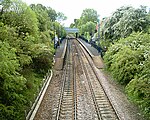Church of St Andrew the Apostle, Bolton upon Dearne
14th-century church buildings in EnglandChurch of England church buildings in South YorkshireEnglish church stubsGrade I listed churches in South Yorkshire

The Church of St Andrew the Apostle is the parish church in the village of Bolton upon Dearne in South Yorkshire, England. It is a Church of England church in the Diocese of Sheffield. The building is Grade I listed and features a Saxon nave incorporating arcade from the 12th century. Additions and alterations include the 14th century chancel and north aisle, a 15th/16th century tower and a 19th-century north chapel and vestry. The church contains memorial plaques for parishioners killed in the First and Second World Wars.
Excerpt from the Wikipedia article Church of St Andrew the Apostle, Bolton upon Dearne (License: CC BY-SA 3.0, Authors, Images).Church of St Andrew the Apostle, Bolton upon Dearne
Furlong Road,
Geographical coordinates (GPS) Address Nearby Places Show on map
Geographical coordinates (GPS)
| Latitude | Longitude |
|---|---|
| N 53.5197 ° | E -1.31482 ° |
Address
Furlong Road
Furlong Road
S63 8HB
England, United Kingdom
Open on Google Maps






